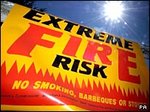The primary risk to people in a fire is smoke inhalation (breathing in smoke); most of those killed in fires die from this, not from burns. The risks of smoke include:
* suffocation due to the fire consuming or displacing all the oxygen from the air;
* poisonous gases produced by the fire;
* aspirating heated smoke that can burn the inside of the lungs.
As an example, plastics inside a car can generate 200,000 m3 of smoke at a rate of 20-30 m3/sec. Firefighters carry self-contained breathing apparatus (SCBA) (an open-circuit positive pressure compressed air system) to prevent smoke inhalation.
Obvious risks stem from the effects of heat. Even without contact with the flames (conduction), there are a number of comparably serious risks: burns from radiated heat, contact with a hot object, hot gases (e.g., air), steam and hot and/or toxic smoke. Firefighters are equipped with personal protective equipment (PPE) that includes fire-resistant clothing (nomex or polybenzimidazole fiber (PBI)) and helmets that limit the transmission of heat towards the body.
The heat can make pressurised gas cylinders and tanks explode, producing what is called a BLEVE (Boiling Liquid Expanding Vapor Explosion). Some chemical products such as ammonium nitrate fertilizers can also explode. Explosions can cause physical trauma or potentially serious blast or shrapnel injuries.
Heat causes human flesh to burn as fuel causing severe medical problems. Depending upon the heat of the fire, burns can occur in a fraction of a second. A first degree burn (on the skin surface) is extremely painful. A second degree burn is a burn into the skin, and can cause shock, infections, and dehydration and if left untreated often results in death. Second degree burns compromise nerve tissue and are not painful. Third degree burns leave muscles and internal organs exposed from completely destroyed skin. If the person survives the shock and exposure to germs, medical treatment is extremely difficult.
By Wikipedia
* suffocation due to the fire consuming or displacing all the oxygen from the air;
* poisonous gases produced by the fire;
* aspirating heated smoke that can burn the inside of the lungs.
As an example, plastics inside a car can generate 200,000 m3 of smoke at a rate of 20-30 m3/sec. Firefighters carry self-contained breathing apparatus (SCBA) (an open-circuit positive pressure compressed air system) to prevent smoke inhalation.
Obvious risks stem from the effects of heat. Even without contact with the flames (conduction), there are a number of comparably serious risks: burns from radiated heat, contact with a hot object, hot gases (e.g., air), steam and hot and/or toxic smoke. Firefighters are equipped with personal protective equipment (PPE) that includes fire-resistant clothing (nomex or polybenzimidazole fiber (PBI)) and helmets that limit the transmission of heat towards the body.
The heat can make pressurised gas cylinders and tanks explode, producing what is called a BLEVE (Boiling Liquid Expanding Vapor Explosion). Some chemical products such as ammonium nitrate fertilizers can also explode. Explosions can cause physical trauma or potentially serious blast or shrapnel injuries.
Heat causes human flesh to burn as fuel causing severe medical problems. Depending upon the heat of the fire, burns can occur in a fraction of a second. A first degree burn (on the skin surface) is extremely painful. A second degree burn is a burn into the skin, and can cause shock, infections, and dehydration and if left untreated often results in death. Second degree burns compromise nerve tissue and are not painful. Third degree burns leave muscles and internal organs exposed from completely destroyed skin. If the person survives the shock and exposure to germs, medical treatment is extremely difficult.
By Wikipedia



No comments:
Post a Comment